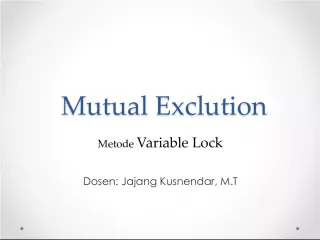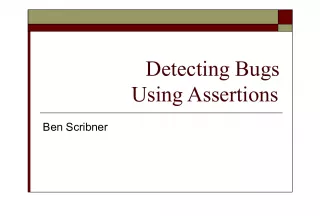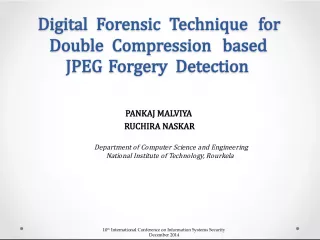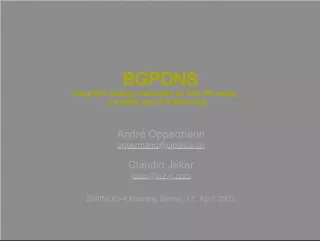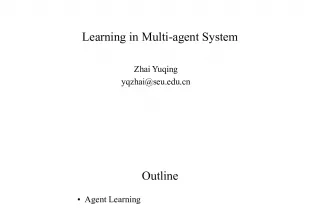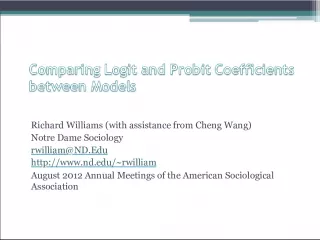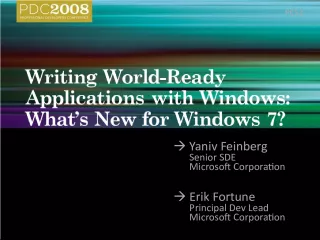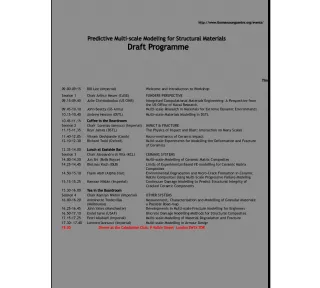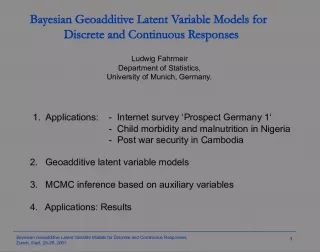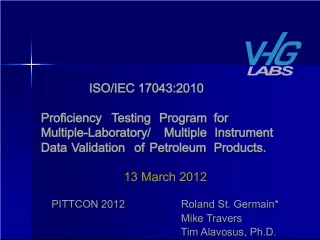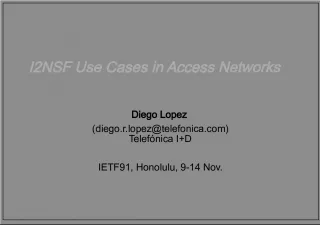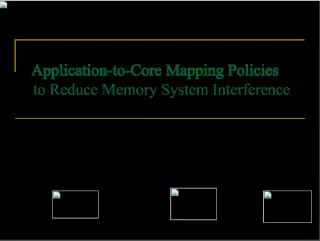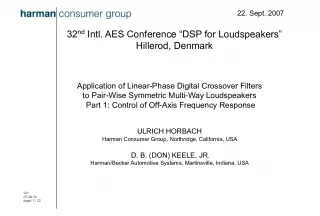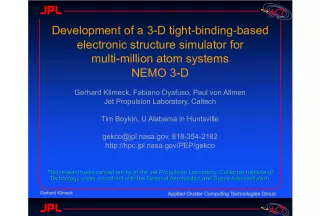MUVI: Automated Detection of Multi-Variable Access Correlations and Bugs


MUVI is a software tool developed by a team of researchers from the University of Illinois, designed to automatically infer multi-variable access correlations and detect related
- Uploaded on | 2 Views
-
 isabellagrant
isabellagrant
About MUVI: Automated Detection of Multi-Variable Access Correlations and Bugs
PowerPoint presentation about 'MUVI: Automated Detection of Multi-Variable Access Correlations and Bugs'. This presentation describes the topic on MUVI is a software tool developed by a team of researchers from the University of Illinois, designed to automatically infer multi-variable access correlations and detect related. The key topics included in this slideshow are . Download this presentation absolutely free.
Presentation Transcript
Slide1MUVI: Automatically InferringMulti-Variable Access Correlations and Detecting Related Semantic and Concurrency Bugs Shan Lu ( shanlu@cs.uiuc.edu ) Shan Lu , Soyeon Park , Chongfeng Hu , Xiao Ma, Weihang Jiang, Zhenmin Li, Raluca A. Popa, and Yuanyuan Zhou University of Illinois http://opera.cs.uiuc.edu
Slide2Bugs are bad! Software bugs are costly! Account for 40% of system failures [Marcus2000] Cost US economy $59.5 billion annually [NIST] Techniques to improve program correctness are desired
Slide3Software bug categories Memory bugs Improper memory accesses and usage A lot of study and effective detection tools Semantic bugs Violation to the design requirements or programmer intentions Biggest part (~80%*) of software bugs No silver bullet Concurrency bugs Wrong synchronization in concurrent execution Increasingly important with the pervading concurrent program trend Hard to detect * Have Things Changed Now? -- An Empirical Study of Bug Characteristics in Modern Open Source Software [ACID’06]
Slide4An important type of semantic information Software programs contain many variables Variables are NOT isolated Semantic bond exists among variables Correct programs consistently access correlated variables x y z s t u v w Variable Access Correlation
Slide5Variable correlation in programs Semantic correlation widely exists among variables struct fb_var_screeninfo { … int red_msb; int blue_msb; int green_msb; int transp_msb; } Linux Different aspects struct net_device_stats { … long rv_packets long rv_bytes; } Linux Different representation struct st_test_file * cur_file; struct st_test_file * file_stack; MySQL Implementation -demand Class THD { … char* db; int db_length; } MySQL Constraint specification 4
Slide6write ( ) write ( ) Variable access correlation ( constraint ) Maintaining correlation usually needs consistent access db db_length red/…/transp red/…/transp A1 ( x ) A2 ( y ) access read write access read write rv_packets rv_bytes file_stack cur_file write ( ) access * ( ) write ( ) write ( ) access ( ) access ( ) Variable access correlation *access: read or write
Slide7Violating the correlations leads to bugs Programmers may forget to access correlated variables A type of semantic bugs not handled by previous tools Correlated variables Mostly consistent access --- correct Inconsistent access --- BUG! Confirmed by Linux developers Inconsistent update bugs More examples of inconsistent update bugs are in our paper.
Slide8Programmers may forget to synchronize concurrent accesses to correlated variables This is NOT a traditional data race bug Bug occurs even if accesses to each single variable are well synchronized js_FlushPropertyCache ( … ) { memset ( cache table , 0, SIZE); … cache empty = TRUE; } js_PropertyCacheFill ( … ) { cache table [indx] = obj; … cache empty = FALSE; } Violating the correlations leads to bugs (ii) Multi-variable concurrency bugs struct JSCache { … JSEntry table[SIZE]; b ool empty; } Thread 1 Thread 2 lock ( T ) unlock ( T ) unlock ( T ) lock ( E ) unlock ( E ) Mozilla lock ( T ) unlock ( E ) lock ( E ) BUG
Slide9Our contribution A technique to automatically infer variable access correlation Bug detection based on variable access correlation Inconsistent-update semantic bugs Multi-variable concurrency bugs Disclose correlations and new bugs from real-world applications (Linux -device_driver , Mozilla, MySQL, Httpd) > 6000 variable correlations 39 new inconsistent-update semantic bugs 4 new multi-variable concurrency bugs from Mozilla
Slide10Outline Motivation What is variable access correlation MUVI variable access correlation inference MUVI bug detection Inconsistent-update semantic bug detection Multi-variable concurrency bug detection Evaluation Conclusions
Slide11Accesscorrelation Basic idea of correlation inference Our target: Our inference method: Assumption: mature program, mostly correct x and y appear together in many time s x and y s eldom appear separately Statistically infer access correlation based on variable access pattern in source code access correlation A1 ( x ) A2 ( y ) How to judge `` together ’’ ? Our metric: static code distance within a function scope Our paper talks about other potential metrics How to do this efficiently?
Slide12Frequent itemset mining A common data mining technique Itemset: a set of items ( no order ) E.g. (v, w, x, y, z) Sub-itemset : E.g. (w, y) Itemset database Goal: find frequent sub-itemsets in an itemset database Support: number of appearances E.g. support of (w, y) is 3 F requent : support > threshold (v, x, m, n) (v, w, y, t ) (v, w, y, z, s ) ( v, w, x, y, z )
Slide13Flowchart of variable correlation inference Source files Mining Frequent variable sets Itemset Database Pre-processing Variable access correlation Post-processing How? How?
Slide14MUVI Inference algorithm (pre-process) Program Source Code Itemset Database ? What is an item? A variable What is an itemset? A function What to put into an itemset? Accessed variables Access type (read/write)
Slide15MUVI Inference algorithm (pre-process) Input: program Output: an itemset database Flow-insensitive, inter-procedural analysis Consider G lobal variables and structure-typed variables Also consider variables accessed in callee functions …… … {read, z} f3 {write, S::y} f2 {read, x} f1 Database int x; f1 ( ) { read x; } f2 ( ) { S t; write t.y; } int z; f3 ( ) { read z; f1 ( ); f2 ( ); } {read, x} {write, S::y} f1 f2 f3
Slide16MUVI Inference algorithm (post-process) Input: frequent variable sets (x, y), which appear together in many functions Pruning What if x and y appear separately many times? Prune out low confidence (conditional probability) pairs What if x is too popular, e.g. stderr, stdout? Categorize based on access type write (x) write (y)? Or write (x) read (y)? etc. Output: variable correlation A1 ( x ) A2 ( y )
Slide17Outline Motivation MUVI variable access correlation inference MUVI bug detection Inconsistent-update semantic bug detection Multi-variable concurrency bug detection Evaluation Conclusions
Slide18Inconsistent-update bug detection Step 1: get all write(x) acc(y) correlations Step 2: get all violations to above correlations Step 3: prune out unlikely bugs Code analysis to check caller and callee functions write (fb_var_screeninfo::blue_msb) access (fb_var_screeninfo::transp_msb) #support = 11 #violation = 1 (function neofb_check_var ) inconsistent-update bug
Slide19Multi-variable concurrency bug detection-- MUVI Lock-set algorithm Original algorithm Look for common locks among conflicting accesses to each shared variable MV Lock-Set algorithm Look for common locks among conflicting accesses to each shared variable and their correlated accesses
Slide20Multi-variable concurrency bug detection-- Other MUVI extension algorithm MUVI happens-before algorithm Check the happens-before relation among conflicting accesses to each single variable Check the happens-before relation among conflicting accesses to each single variable and correlated accesses Other extension Extending hybrid race detection Extending atomicity violation bug detection
Slide21Outline Motivation MUVI variable access correlation inference MUVI bug detection Inconsistent-update semantic bug detection Multi-variable concurrency bug detection Evaluation Conclusions
Slide22Methodology For variable correlation and inconsistent-update bug detection: Linux (device driver) Mozilla MySQL PostgreSQL For multi-variable concurrency bug detection: F ive existing real bugs fr om Mozilla and MySQL All latest versions Find four new multi-variable concurrency bugs during the detection process
Slide23Results on correlation inferenceApp. #Access- Correlation #Involved Variables %False Positives Analysis Time Mozilla 1431 1380 16% 157m MySQL 726 703 13% 19m Linux 3353 3038 19% 175m Postgre-SQL 939 833 15% 98m Macro, inline functions coincidence
Slide24Inconsistent-update bug detection resultsApp. # of MUVI bug report # of new bugs found # of bad programming # of false positives Linux 40 22 (12) 5 13 Mozilla 30 7 (0) 8 15 MySQL 20 9 (5) 3 8 Postgre-SQL 10 1 (0) 4 5 Semantic exceptions Wrong correlations No future read access
Slide25MV-Happens-Before has similar results Multi-variable concurrency bug detection results Bug MV-Lockset Detect Bug? False Positive Moz-js1 Y 1 Moz-js2 Y 2 Moz-imap Y 0 MySQL-log Y 3 MySQL-blog N 0 Variables are conditionally correlated The correlation is missed by MUVI
Slide26Multi-variable concurrency bug detection results 4 new multi-variable concurrency bugs detected! Wrong result!
Slide27Conclusion V ariable access correlations can be inferred V ariable access correlation is important Help detect two types of bugs Other usage Provide specifications to ease programming Provide hints for assigning locks or TMs E.g. AtomicSet, AutoLocker, Colorama
Slide28Related works Program specification inference [ErnstICSE00], [EnglerSOSP01], [KremenekOSDI06], [LiblitPLDI03], [WhaleyISSTA02], [YangICSE06], etc. Code pattern mining [LiOSDI04], [LiFSE05], [LivshitsFSE05], etc. Concurrency bug detection [ChoiPLDI02], [EnglerSOSP03], [FlanaganPOPL04], [SavageTOCS97], [Praun01], [XuPLDI05], [YuSOSP05], etc. Techniques for easing concurrent programming [Harris03], [HerlihyISCA93], [McCloskeyPOPL06], [Rajwar02], [Hammond04], [Moore6], [Rossbach07], etc.
Slide29Acknowledgement Prof. Stefan Savage (shepherd) Anonymous reviewers Prof. Liviu Iftode GOOGLE student travel grant NSF, DOE, Intel research grants
Slide30Thanks!http://opera.cs.uiuc.edu
